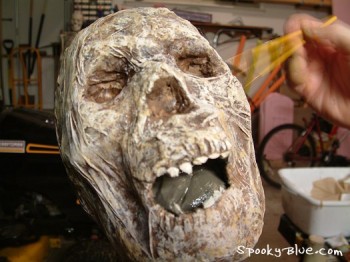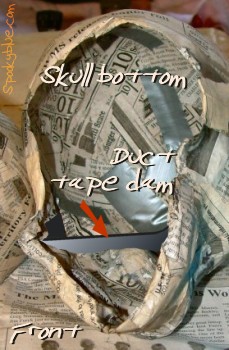What Rod Serling was always going on about
 How many corndogs is too many?
How many corndogs is too many?
Do you think that they’ll ever clone veloci-raptors, and that they’ll be smart enough to work a doorknob?
From time to time the pipeline deposits a question for me that warrants extra attention here. Neither of these is one of those. But this, now …
How do you scare someone?
What a question! And seeing as how the first 2009 4H haunted house planning session is coming up very soon, it’s a topic worth looking at.
The way I see it, an authentic scare falls into one of four categories, and each involves a certain level of difficulty in order to pull off.
I. Shock …
This is the most basic and over-used scare device in the haunted house trick bag because it doesn’t weigh anything, doesn’t require any thought; so it always floats to the top. Jason, in this room you jump out of this alcove. Freddie, in this room, you jump from behind that wall. Michael, in this room, you jump from behind those curtains. The only people who’ll scream every time are the hamster girls. You might get a few others to jump once or twice, but it quickly becomes a tiresome game of Whack-a-mole.
II. Deception and shock …
Here’s where you start getting into the psychology of a scare. In essence, you get the person’s attention, then pull the rug out from under him. Good examples are:
A. The dark hallway with a high light shining into patrons’ eyes. All they can see is the light, and they have no other option, so they walk toward it. What they don’t see until they’ve passed beneath the light beam is the actor or prop that has suddenly materialized before them.
B. It’s done to death, but it remains effective; one actor keeps the audience’s attention while another actor sneaks up from behind and growls, grunts, roars, or simply waits for the hamster girls to notice him. Do it early, and they’ll look over their shoulders for a while. Do it in every room and somebody’s going to get smacked in the head if they don’t – get – out – mah – face!
C. Drop panels can be employed counterintuitively to great effect. Patrons enter a small room, or narrow hallway. Their attention is directed at some point or scene. At a trigger, the walls drop away on either side (hallway) or behind them (small room) to reveal a large (and well-lit) group of monsters reaching and shambling toward them.
III. Impending doom …
This is much more difficult to achieve because it requires that you create an atmosphere that is not only discomforting, but is also sustainable. A dark, wet tomb that smells of mold. A dry and windy rooftop. A creaky bridge. A ghost-filled cemetery with half-seen spirits around every tombstone. Or a large, empty room with one spotlight shining on a box, and arrows on the floor telling you to go to the box. What’s in the box?
It’s the goal. What’s the goal? The thing in the box. (It’s got the electrolytes plants crave)
The goal, whatever it is, stands at the far end of this frightening place. It is the object that draws you through the scene, but you dread reaching it because you just know it’s going to bring down hell and carp on your head. It is preferably the most well-lit object -key, door, book, button, skull, rat, refrigerator- in the room. If you’ve got the real estate to spare, make this a very large room, dimly lit except for a path and the object. By the time the rubes have reached the goal, they’ll be so shaken because nothing has happened -yet- that your grandma could step out of the refrigerator and show them her teeth. A 20′ tall cybernetic minotaur with rocket launcher and laser eyes would also work.
IV. Utter bewilderment …
When perception and reason suddenly don’t jibe anymore, you’ve reached a special place. This is the stuff Rod Serling was always going on about. The thing that caused Ray to go bye-bye and left Egon terrified beyond the capacity for rational thought.
We accept certain things as everyday, mundane, humble, and expected. The same is true in a haunted house. Now suppose you present the patron with something utterly senseless and illogical, something far beyond reason or common sense. It becomes unreal. Yet there it is, and it’s coming right at him. Whether or not he accepts its reality (and this is hard to do), psychologically, you own that person’s mind for a few seconds.
A. Patrons enter a room with an actor pretending to be a guide or part of the group. Attention is focused on this person while a black shape swoops down from the rafters, grabs the actor, and they both rise into the pitch black above. Hard to pull off? Yep. Dangerous? You betcha. Think somebody’ll freak out when they see it? Very likely.
B. Patrons see a monster shape or a glowing face in the corner. As they get closer, the shape begins to rise up, slowly unfold. Over the course of 10 seconds, the legs grow impossibly long and the arms reach over patrons’ heads. A slightly less ambitious version involves an actor on drywall stilts. Stalk-arounds are excellent candidates for this kind of scare.
C. I really hate to use this as an example because the “unfold the scare” concept is more subtle. However, if you study the man on the right (you’ve seen this 100 times already), he perfectly illustrates what happens when someone reaches his limit for common-sense-contrariness, however pathetically small it may be.

 It is a scientific fact that one must have a tongue in order to utter the word “brains”. Lacking a licker, you can only attempt a lesser approximation like “bramff”.
It is a scientific fact that one must have a tongue in order to utter the word “brains”. Lacking a licker, you can only attempt a lesser approximation like “bramff”. Fill your skull with mush, leaving the mouth empty. Next, place more duct tape under the chin so that it sticks to the jaw bone, but hangs down a little bit like a pelican, or the unnervingly loose neck-skin of my junior year psychology teacher who pronounced “polygamy” as two distinct words; “polly” “gammy”. I believe he was also active in the hog farming industry.
Fill your skull with mush, leaving the mouth empty. Next, place more duct tape under the chin so that it sticks to the jaw bone, but hangs down a little bit like a pelican, or the unnervingly loose neck-skin of my junior year psychology teacher who pronounced “polygamy” as two distinct words; “polly” “gammy”. I believe he was also active in the hog farming industry.





 While waiting for the dogs to finish their breakfast this morning, I went out and restarted the waterfall pump for the finally-thawed-out fish pond. It has been an oblong collie ice skating rink for weeks.
While waiting for the dogs to finish their breakfast this morning, I went out and restarted the waterfall pump for the finally-thawed-out fish pond. It has been an oblong collie ice skating rink for weeks. A small audience of herding animals had gathered to watch from the porch above me. First appeared the collie who only eats when it’s absolutely necessary, preferring toast and jam to kibble. Then came the sheepdog who will eat almost anything handed to her, but who will sit in front of her half-full supper dish like a petulant child glooming over cold green beans long after the family has left the table to watch A-Team. And last, licking her lips with relish, came the collie who always waits patiently for the opportunity to helpfully clean up after brother and sister; and sometimes not really waiting for after to arrive.
A small audience of herding animals had gathered to watch from the porch above me. First appeared the collie who only eats when it’s absolutely necessary, preferring toast and jam to kibble. Then came the sheepdog who will eat almost anything handed to her, but who will sit in front of her half-full supper dish like a petulant child glooming over cold green beans long after the family has left the table to watch A-Team. And last, licking her lips with relish, came the collie who always waits patiently for the opportunity to helpfully clean up after brother and sister; and sometimes not really waiting for after to arrive. My brother’s birthday is in late September, so he can generally expect to get a skeleton or a box of vampire bats from me.
My brother’s birthday is in late September, so he can generally expect to get a skeleton or a box of vampire bats from me.

